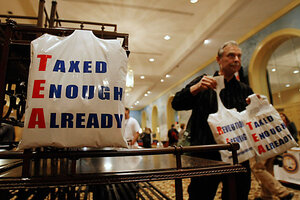‘Tea party’ movement: lessons from earlier uprisings
While movements like the tea party have fervor and anger, historians caution that such groups can quickly lose momentum and influence.

Bill Bruss of Winfield, Ill., gives away plastic bags in the vendor area at the first ever Tea Party Nation Convention in Nashville, this weekend.
Ed Reinke/AP
Nashville, Tenn.
The first-ever Tea Party Nation convention this weekend in Nashville, Tenn., taps into two great, and sometimes troubling, traditions in American history – both of which have to do with the unique democratic experiment that is America.
On the one hand is the Jeffersonian strain – a return to the ideals of the individual and the blessings of small, restrained government. On the other hand is a strain of McCarthy-type paranoia that started well before the mid-1900s. In the 1850s, it gave rise to the anti-immigrant Know-Nothing Party, and according to some critics, it was a factor in the xenophobic supremacist movements of the late 20th century.
Now, at the “tea party” convention, the fractious movement will try to agree on its basic principles. It will also try to decide whether to wield its growing power locally or nationally.
“This is one of these moments we’re going to be teaching in 20 years,” says Robert Watson, a political science professor at Lynn University, in Boca Raton, Fla. “It’s a moment that changes America’s democracy and citizen involvement.”
But while movements like the tea party have fervor and anger, historians caution that such groups can quickly lose momentum and influence: Their passion might be absorbed by one of the two main political parties, or their complaints could be addressed by changing circumstances.
Political historians draw a parallel between the tea-party movement and the populist movement of the 1880s. Back then, yeoman farmers in the West and South built a political base by pushing back against the influence of railroad barons and corporate grain operators.
Under the banner of the People’s Party, these populists got 8 percent of the presidential vote in 1892, with James Weaver as their candidate. They carried four states in that election.
But times were about to change. “Then, some in the movement make an alliance with the Democrats” ahead of the 1896 election, says Tom De Luca, a political science professor at Fordham University in New York. “They go down in defeat, and the populist movement is weakened and fades. Those kinds of decisions are in store for the tea party.”
The tea party has been divided about how closely it should align itself with the GOP.
The path ahead for such a movement can be challenging, Professor De Luca says. By trying to wield more national power, “you have a movement with its own base, and then it tries to fight its way through an electoral system that is horrible for third parties,” he says.
One of the most direct and recent parallels happened not on the Potomac, but in Paris.
In the 1950s, the tax revolters called the Poujadists, led by a stocky shopkeeper named Pierre Poujade, culminated in an anti-elitist and anti-parliamentarian protest that had a heavy impact on the 1956 French elections.
Like the tea partyers, the Poujadists had witty signs protesting the urban professional class that had lost contact “with the real world.” And like the tea-party movement, the Poujadists lacked a platform (although the tea party is working on one).
In another parallel, “[t]he group’s rallying cry – Sortez les sortants! (‘Throw the bums out!’) – challenged the right as well as the left,” Robert Zaretsky, a professor of French history at the University of Houston’s Honors College, wrote recently in The New York Times.
“During the ... elections, the Poujadists bulldozed their way into town meetings, shouting down opposing candidates ...: a grim rehearsal for Tea Party tactics during last year’s health care debates,” Prof. Zaretsky wrote. But once the Poujadists gained power, “[s]logans and placards were poor preparation for governance,” he added.
Professor Watson says that the tea party also taps into what he calls a “deeper xenophobic feeling.” That’s been fueled, he says, by a decade that saw two long wars, a meltdown of the US economy, and the election of “a black president with a strange name.”
“You saw it with the John Birch Society, the Sagebrush Rebellion, the conspiracy theory stuff on the radical right and left: We’ve always had this paranoid element percolating,” Watson says.
Historical parallels show how difficult it can be to steer a political insurgency in an entrenched two-party system. It’s a system that can breed, as De Luca says, “the kind of resentment that comes with powerlessness.”
But what’s different this time, Watson says, is that technology like Facebook and Twitter has allowed “the fringe ... to come to the fore with a big bullhorn.”
-----
Follow us on Twitter.
